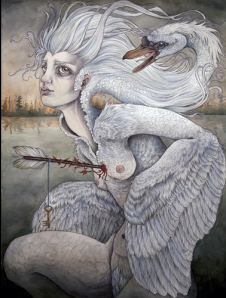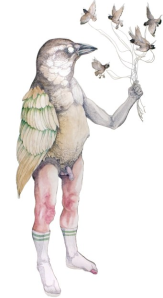Caitlin Hackett: Drawings of mutated creatures ask, “What is natural?”
 |
 |
| The Swan Maiden | A Flightless Bird |
 |
 |
| Vulpes Masquerade | Untitled |
 |
 |
| Untitled | Untitled |
In her work, Caitlin Hackett tackles a subject that personally fascinates me: the difference between an animal as it actually exists and behaves, and the way that animal is seen in our human understanding, layered with symbolism, stereotypes, and sometimes misinformation.
With an upbringing that fostered a “respect and love [for] the natural world” and an interest in how humans have affected, or are a part of, that world, Hackett imbues into her ballpoint-and-watercolor drawings a sense reverence and disgust, hope and despair. Human and animal forms are mingled in sometimes subtle and often grotesque ways, referencing mythology, misconception, and modern issues of environmental decline.
Her drawings ask us about our own relationship to animals, and our place as natural creatures. Undeniably, humans have affected the rest of the animal world, and it has affected us: Hackett points this out to us by giving hands to wading birds, a sparrow’s feathers to a half-naked boy, dresses to deep-sea fish, and rotting fur to a woman – or is it a woman’s face to a dead fox? In these drawings, as in life, humans and animals are inextricably intertwined, with results that are fascinating, beautiful, and sinister.
From Hackett’s statement:
…My work alludes to the boundaries that separate humans from animals both physically and metaphysically, and how these boundaries are warped by new scientific data, mythology, history and religious beliefs alike, blurring the lines between us as science, religion and culture clash over what it is to be human, and thus, what separates us from the beasts of the wild. I am fascinated by the way in which people personify or objectify animals; the way in which the human view of an animal can render it into an object of utility, or a trustworthy companion, or a monstrosity, regardless of that creatures true nature. It is this dichotomy that I aim to reveal in my work, the ‘real’ animal versus the abstract animal as it exists in the human mind, an animal mutated by social constructs and mythology alike. The symbolic meaning attributed to different species correlates directly with how they are treated in the real world; which creatures are protected and which are not, which are vilified, which are adored, and which are ignored altogether. Whether or not the symbolic meaning humanity has assigned any given species has any relation to reality is not important to most people, it’s the symbolism that matters, the ability to use the animal to suit our own needs, to reach our bottom line. We use the boundary between ‘us’ and ‘them’ to determine an animals fundamental worth, all based on our own desires. It is this process of transforming the animal that inspires my work, and gives it its often dark undertones.
I create pseudo-mythical, mutated, and anthropomorphic creatures using ballpoint pen and watercolor as my primary mediums, almost exclusively on paper. With my work I attempt to capture the often volatile human-animal relationship. I am faced with the fact that we live in a planet in decline, where nearly every natural ecosystem in the world is withering away. Human kind has created a planet of refugees; animals forced to flee ever farther from the insatiable encroachment of urban development, victims of a war for space which they cannot hope to win. My drawings refer to this decline and to the refugees it has created. I am left with the question of what is natural; are we (human beings) still a part of nature? If so, does that make all that we have created, cities, vehicles, factories, all technology, part of nature as well? As we try to separate ever more from our primal nature, will we be able to still see and understand the importance of other animals and our relationship to them?Much more of Caitlin Hackett’s work, and information about her and her process, can be found on her website.